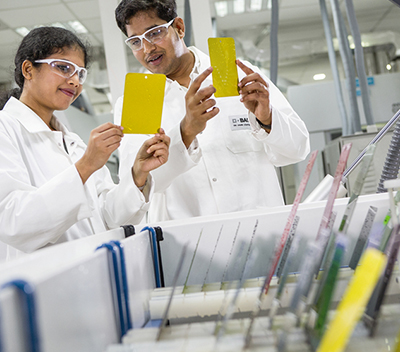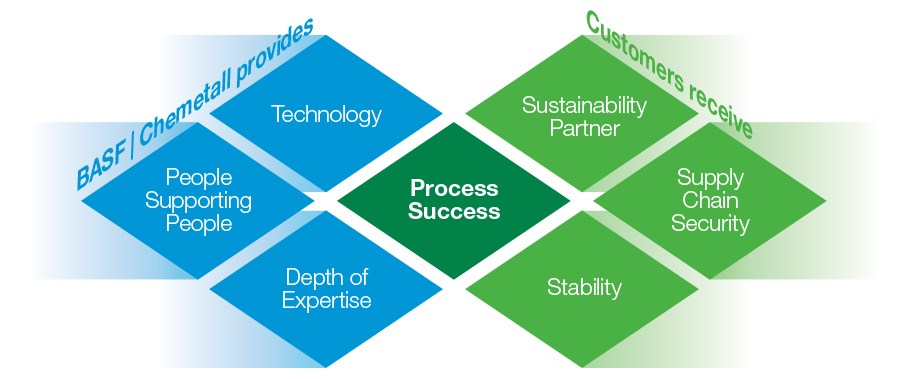How to achieve sustainable detackification
Sustainability
- Reduce impact on environment
- Cleaner production workspace
- Decrease operational cost
How we did it:
- Identify and assess challenge
- Apply MOC process
- Sustainable Solution Steering
- Create an integrated solution
- Clear targets are set
- Hold the gains
Combining expertise and process improvement to achieve sustainability goals.
A major recreational vehicle manufacturer was struggling with a paint detackification
process that was generating excessive solids and sludge, as well as challenges with
water and turbidity levels. The result was expensive and inefficient chemical usage
and maintenance. BASF | Chemetall, with broad expertise and portfolio, had the
opportunity to apply intelligence, creativity, and an established methodology, and
achieve sustainability.
STEP 1 { Identify and assess challenge
The incumbent program had a history of high chemical usage and expensive maintenance. These costs impacted sludge volume and consistency and created the need for multiple cleanouts each year. The detack pit was pumped, hauled, and treated by a third party environmental company. Reducing cleanouts creates an immediate cost savings.
STEP 2 { Apply MOC process
We analyzed the challenges using our proprietary integrated solution methodology (MOC process), a comprehensive technique to address all input and output issues associated with a chemical application.
STEP 3 { Sustainable Solution Steering
What we learn is then filtered through our proprietary Sustainable Solution Steering and applied to the unfolding analysis.
STEP 4 { Create an integrated solution
Next, we analyze through the various views in order to align all program goals and create the concise and encompassing execution plan to solve the problem.
STEP 5 { Clear targets are set
BASF | Chemetall will provide solutions that will:
- Reduce chemical usage
- Reduce sludge volume
- Extend system operation time
- Increase water quality
STEP 6 { Hold the gains
- Customer support
- Data tracking
- Build a partnership
Sustainability
- Reduce impact on environment
- Cleaners production workspace
- Decrease operational cost
Reduce impact on environment
- Turbidity specification of <100 Nephelometric Turbidity Units (NTU) limit achieved and in fact exceeded, frequently testing at less that 50 NTU turbidity
- Superior solids removal and clearer water
- Increase efficiency detackifying solids
- Easy to handle dense dry sludge from improved agglomeration
- Overall decrease in sludge
- Reduce system cleaning, reduce waste generation, and reduce disposal
- Reduce overall chemicals used, reduce foam, and reduce additives
- Reduce chemical footprint of plant

Improving the working environment for the operators and maintenance personnel is a key objective of the Chemetall program and commitment to safety.
It is Chemetall's objective to achieve the highest standards in safety, health and environment protection in everything we do, specifically with regard to our customers, our employees and facilities worldwide.
Cleaner production workspace
- Reduce contact with additive chemicals due to elimination of need for over-the-side additions
- Reduce manpower/maintenance time in confined space due to 3X reduction in cleaning need
- Improve safety of detackification system area due to elimination of foam over of process tank
- Reduced operator time testing and adjusting chemical feeds to keep system operating within parameters
Decrease operational cost
- BASF | Chemetall recommended our Gardofloc® 8528 Paint System
- A sludge removal system was created to allow clean solution to recirculate to the paint spray booth
- This improvement was accomplished with
| Chemical Impact |
| | Cost savings | $20,228.80 |
| Process Impact |
| | Cost savings | $36,993.00 |
| BASF | Chemetall Impact |
| | Cost savings | $8,100.00 |
| Total Cost Impact | $65,321.80 |

Build a partnership through support
- On-site service regularly scheduled
- Continuous improvement initiatives
- Written service reports
- Laboratory and Field Technical Group Support
We've got you covered
Our process success is achieved through our experts and
the integrated technology they bring to the table
- Local support
- Technical support
- Corporate support

Download a PDF of this case study click here.